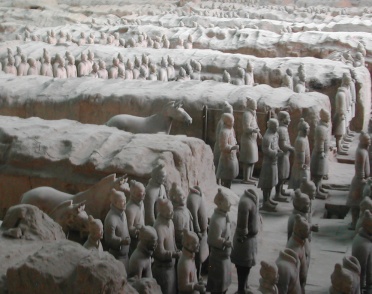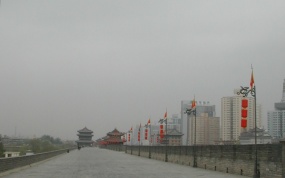XIAN
Xian, which means ‘western peace’, is 750 miles southwest of Beijing. Xian was the center of Chinese political power for 11 dynasties over almost 2,500 years. It was previously the capital of all of China, and it remains the capital of modern Shaanxi province. It has a population nearing 7 million.
The Western Zhou dynasty was first to establish its capital near Xian, then called Changan, in 1066 BC. The Qin dynasty, in which Emperor Qin Shi Huangdi united all of China, left its extensive legacy in and around Xian. It was also the home of the Tang dynasty (618-907 AD) which left a colorful legacy. Xian remained the capital of China until the third Ming emperor, Yongle, moved the capital to Beijing in 1420.
Xian was the eastern end of the Silk Road over which trade developed, and wealth poured in. By the 9th century, in the late Tang dynasty, Xian was the largest and wealthiest city in the world. The population was more than one million, and there were more than 1,000 temples within the vast city wall. The Silk Road also brought people of different ethnicities and faiths, and Xian remains a culturally diverse city.
Xian is rich in history, and it is the home of the Shaanxi History Museum. Its historical richness has long drawn a moderate amount of tourism to the area. However, the Terracotta army was discovered in 1974, and Xian has since become a priority to most tourists visiting China. It was a ‘must see’ for us, and we were not disappointed.
This architecturally attractive building houses more than 370,000 relics dating back to prehistoric times. There are collections of bronzes, pottery, jade, ethnic clothing, furniture, and more. The collections are well displayed, and information is provided in both Chinese and English. There is more here than can be experienced in a single day.
This is a state run factory that reproduces various sizes – from about 4” tall to life sized – of a few of the more recognized terracotta warriors. They also make and sell jade-decorated lacquered furniture and silk hand tied rugs.
They provide useful information on the making of terracotta figures, and it is interesting to watch them made. And, of course, they also sell them.
Some of their lacquer finishes were nice; however, they do not do any inlaying of jade – it is all glued on the finished piece. Although it is visually attractive, it lacks the artistry of inlaid work, and it would be a maintenance nightmare.
The silk carpets were lush. We particularly liked a small ‘prayer rug’ that supposedly had 1,000 knots per square inch and a texture like velvet.
However, this experience was a slightly milder version of the experience we had at the state run jade factory outside Beijing. The sales persons were pushy, and they quickly convinced us that we did not want to buy anything from them. We were ready to go see the real terracotta warriors!

8,000 Life-size warriors in formation
Emperor Qin Shi Huangdi, the emperor who united all of China in 221 BC, was a ruthless despot with many enemies. He was also reportedly preoccupied with death and his own legacy. He left quite a legacy – only a small fraction of it known to date.
In 1974, some local peasants were digging a well and came across some terracotta shards. As more shards were unearthed, the diggers realized that they might have found something of historical interest, and they stopped digging and notified local authorities. Indeed, those shards were the location of one of the most significant archaeological discoveries of the 20th century. Those shards were the beginning of the massive archeological digs that continue today and will likely continue for years to come.
Emperor Qin Shi Huangdi had ordered the development of a massive necropolis of which the terracotta army was one component. Shards from the terracotta army are what the farmers found while digging a well.
The terracotta army was designed to protect Qin Shi Huangdi in the afterlife. Archeologists have uncovered approximately 8,000 life sized warriors and horses so far. Each warrior is unique. Each has a unique face, hair, dress, etc. with remarkable detail such as the tread on the soles of their shoes.
The army is arranged in three ‘pits’ near one another. The total area of these pits is approximately 225,000 square feet – more than five acres.
The first and largest pit measures 750 feet long by 200 feet wide with a total area of more than 153,000 square feet – just over 3.5 acres. This pit has been well excavated since its discovery in 1974. There are more than 6,000 warriors in pit 1, and there are 45 chariots with horses. The life sized warriors, horses, and chariots are arranged in 9 columns. This army is in a defensive formation.
The second pit, which is still being excavated, is less than half the size of pit one. It measures slightly less than 65,000 square feet – approximately 1.5 acres. Pit 2 contains 11 wooden chariots and 67 pottery chariot horses. It also contains 32 terracotta cavalrymen and 163 terracotta warriors with nearly 900 bronze weapons and 29 pottery horses. These appear to be in four separated groupings.
Pit 3, in which excavation has just begun, is only 5,400 square feet. It appears to be the army’s command center. It contains 1 wooden chariot, 68 terracotta warriors, 4 terracotta horses, and 34 bronze weapons.
The terracotta army is just a piece of Emporer Qin Shi Huangdi’s tomb. There is a large hill nearby that is believed to contain the actual tomb; however, it has not yet been excavated for numerous reasons including rivers of mercury within and surrounding it. However, a few items have been recovered, and they are spectacular. On display nearby are two bronze chariots that have been recovered. Each is half size, and each is made up of more than 3,600 individual pieces. These were found within wooden coffins.
It is estimated that the building of this tomb employed 700,000 to 800,000 workers over more than a decade. Unfortunately, it is also believed that many of those workers as well as the emperor’s concubines were buried alive with him in the actual tomb.
Clearly a few snapshots and brief paragraphs cannot capture the scope of this. It is probably the most amazing man-made thing either of us has ever seen. The interested reader is referred to the April, 1978, issue of National Geographic magazine. This was the cover story of that issue.
It was once common for Chinese cities to be enclosed within walls. The Xian city wall was built in 1370 by the first Ming emperor, Hong Wu. The wall was built of rammed earth, lime, and glutinous rice. The wall was built on the foundations of the former Tang imperial palace. Although most city walls have disintegrated over time, the Xian city wall has been maintained and is intact.
This wall is nine miles long and encloses Xian’s city center which is approximately 1.75 miles north-south and 2.75 miles east-west – a total of 4.8 square miles. The wall is 39 feet high and up to 59 feet thick in places. Although it appears enormous, it is actually a very small version of the city wall that the Tang dynasty had built around 30 square miles of Xian – more than six times the area enclosed by the Ming-built wall. However, the Tang-built wall did not survive.
Visitors can climb the wall and walk around it or even rent bicycles to ride around. It is a great vantage point from which to look over the sights of ancient and modern Xian.

On top of – not outside of – city wall
Xian was located at the eastern end of the historic Silk Road, and numerous ethnicities and faiths entered Xian via that route. A substantial sized Muslim population developed within Xian, and it remains today.
The Great Mosque was built during the Tang dynasty, and it draws many visitors. However, we were more interested in experiencing the slice of life to be found roaming the streets of the Muslim Quarter. It was a rich and colorful marketplace with mostly shops and eateries at street level and living quarters on the second level. The Muslim Quarter is a lively section of town inside the city wall.

Little Wild Goose Pagoda
This pagoda is one of the few surviving structures built during the Tang dynasty. During that time period, most temples were built of wood, and they were at risk of fire. This temple was built to store sacred scriptures brought from India over the Silk Road, and those scriptures needed to be protected from fire, so the temple was built of brick. This 141 foot high pagoda was completed in 709 AD.
Although the temple was fire resistant, it was not invulnerable to earthquakes. Sometime prior to 1487, the top of the pagoda fell off during an earthquake. In 1487, another earthquake caused a large fracture along its length; however, another earthquake a century later reversed the damage.
Although we learned the history of the unusual name of this pagoda, neither of us can remember it. There is also a Big Wild Goose Pagoda.
Tang Dynasty Show – This was an evening show in a dinner theater designed to show off the grandeur of the Tang dynasty. It was a performance of Tang-era dancing in period costumes. We do not know the degree of authenticity in the costumes we saw, but they were magnificent! It was a pleasant evening.
We would have liked to spend more time in Xian, but we could not. We had reservations to fly to Wuhan then drive 200 miles further west to begin our trip up the Yangtse River.